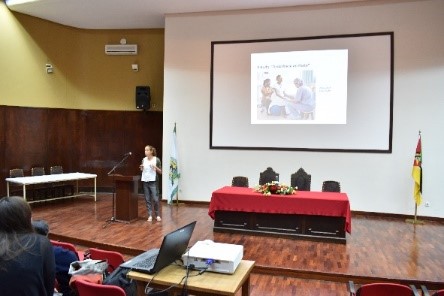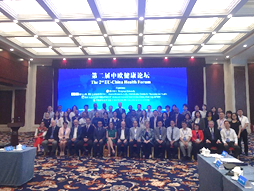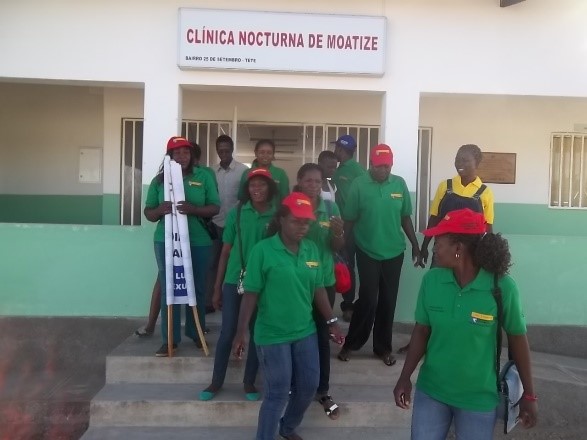Newsletter August 2018
 ICRH Global Newsletter ICRH Global Newsletter 17th of August, 2018
|
Message from the Chair |
| PROJECTS |
Sex workers in Tete, Mozambique |
Gender norms and adolescence |
Sexuality education in Uganda |
| EVENTS |
Festive conference in honour of Prof. Dr. Marleen Temmerman |
Male involvement in maternal health |
Second EU-China Health Forum |
Global Gag Rule |
| Kenya is making positive strides in improving family planning access This is according to ICRHK Country Director and PMA2020/Kenya Principal Investigator, Prof. Peter Gichangi. Speaking on Friday July 13, 2018 during a family planning data discussion on Kenya Television Network, Prof. Gichangi noted that there is continued increase in demand satisfied by modern contraceptive methods and an increase in long acting revisable contraception methods. This he attributed to commitment to family planning programs by government and partners. ‘Women are becoming more aware on what method is very reliable for them. There is increased awareness but more important is the fact that the methods are available. You go to government facilities and private facilities, you find them. Our survey found out 80% of facilities have three to five methods, meaning women have a choice of choosing what is suitable for them’, Prof. Gichangi said. He added that the positive change was not only being experienced at the national level but also at the county level where the county governments have used the survey data to inform family planning policies and interventions. Some counties have doubled their modern contraceptive prevalence rate. The poor were still being left behind in the uptake of family planning compared to the rich. This he attributed to physical, financial and cultural barriers. To counter some of these barriers, Prof. Gichangi suggested the use of community health workers who have a regular contact with the population at the community level amongst other awareness creation mediums like radio, television and newspaper. Watch the discussion HERE. Access the survey findings HERE. |
PUBLICATIONS |
| Hymen reconstruction An analysis of perceptions and experiences of Flemish gynaecologists. Hymen reconstruction (HR) involves the restoration of the hymeneal membranes gross anatomical integrity. Among the medical profession, hymen reconstruction receives particular attention and its necessity is debated because the surgery is not medically indicated, and often reveals conflicting social norms on virginity and marriageability between health professionals and their patients. The focus of this paper is not to address the many open questions that the ethics and politics around HR reveal, but rather aims at contributing to the much-needed empirical evidence. It presents findings of a study conducted in Belgium (Flanders region), among gynaecologists that aimed at assessing their knowledge, views, and experiences on hymen reconstruction. A digital self-administered questionnaire-based survey was sent to Flemish gynaecologists and trainees in Flanders registered with the Flemish Society of Obstetrics and Gynaecology (VVOG). Hundred-and-nine questionnaires were completed. The majority of the respondents (73%) had requests to perform HR. Knowledge and technical skills about HR were considered to be sufficient (69%), even though HR does not seem to be integrated in medical curricula or post-graduate training. Most respondents (72%) would favour the publication of a guideline by their professional organisation. Few respondents discuss alternative options with the patient (19%) and half of the respondents reject to perform HR (49%). The majority of our respondents are against reimbursement of the surgery (70%). Not even half of the respondents believes that a patient is at risk of further violence (47%). 7% of the respondents mentioned complications, but the majority was able to perform a follow up consultation. The responses of this survey cannot be generalised to the entire population of gynaecologists in Flanders, but do provide insights in how gynaecologists confronted with HR are approaching such requests, and thus contributes to the empirical evidence. The paper showed that many Flemish gynaecologist are likely to encounter requests for hymenoplasty, but that a majority would not perform the surgery. There seems to be a lack of guidance and debate in Flanders on the social and moral dimensions of HR, and a number of complexities were revealed when gynaecologists address HR that need further research. Els Leye, Emilomo Ogbe and Maaike Heyerick. Doing hymen reconstruction: an analysis of perceptions and experiences of Flemish gynaecologists. BMC Women's Health (2018) 18:91 https://doi.org/10.1186/s12905-018-0587-z. |
| S&GBV in asylum reception facilities Assessing reported cases of sexual and gender-based violence, causes and preventive strategies, in European asylum reception facilities. Sexual and gender-based violence (SGBV) is a widespread public health problem and a violation of human rights rooted in gender and power inequities. Refugees, asylum-seekers and migrants living in European asylum reception facilities (EARF) are especially vulnerable to SGBV. To contribute to closing the gap on systematic and accurate evidence on SGBV, the authors aim to explore reported cases of SGBV, causes and preventable measures described by residents and professionals from EARF. A cross-sectional study was developed using the Senperforto project database. Semi-structured interviews were conducted with residents (refugees, asylum-seekers and unaccompanied minors) and professionals (service and health care providers) at EARF, in 7 European countries. IBM® SPSS software was used to analyze our data. Further, statistical tests - Chi-square Test and Fisher's exact test (5% significance level) were conducted. In total 562 respondents: 375 residents (R) and 187 professionals (P) participated in the study. The majority of respondents were male (56.9%), aged 19 to 39 years (67.3%). Respondents described 698 cases of SGBV (R 328, P 370), comprising 1110 acts of multi-types of violence. Respondents from Malta (160) and Belgium (143) reported the highest number of SGBV cases. The main reported causes were frustration and stress (R 23.6%, P 37.6%, p 0.008) and differences related with cultural background (R 19.3%, P 20.3%, p 0.884). Respondents assumed that these acts of violence could be prevented by SGBV prevention interventions (R 31.5%, P 24.7%, p 0.293); improving living conditions (R 21.7%, P 15.3%, p 0.232); and promoting communication (R 16.1%, P 28.2%, p 0.042). The majority of R were not aware of existing preventable measures in the asylum facility or host country. While the majority of P were aware of existing preventable measures in the asylum facility or country. Proposed SGBV prevention strategies in EARF included SGBV sensitization and awareness, improving living conditions and improving communication between R and P. In the EARF context, SGBV is characterized by multi-types of violence acts, yet R and P believe that prevention is possible. The results call for urgent integrative prevention strategies that are in line with country-level and international regulations. Oliveira C, Keygnaert I, Oliveira Martins MDR, Dias S. Assessing reported cases of sexual and gender-based violence, causes and preventive strategies, in European asylum reception facilities. Global Health. 2018 May 9;14(1):48. doi: 10.1186/s12992-018-0365-6. |
| Retention in ART in Mozambique Results of a retrospective national cohort analysis on validity of reported retention in antiretroviral therapy after roll-out to peripheral facilities in Mozambique. Retention in anti-retroviral therapy (ART) presents a challenge in sub-Saharan Africa. In Mozambique, after roll-out to peripheral facilities, the 12-month retention rate was reported mostly from sites with an electronic patient tracking system (EPTS), representing only 65% of patients. The authors conducted a nationally representative study, compared 12-month retention at EPTS and non-EPTS sites, and its predictors. Applying a proportionate to population size sampling strategy, a nationally representative sample was obtained of patients who initiated ART between January 2013 and June 2014. Weighted proportions of the patients' status were calculated at 12 months after ART initiation, and 12-month incidence of lost to follow-up (LTFU) and death. Determinants of LTFU and death were assessed by calculating adjusted hazard ratios (AHR) through multivariate cox-proportional hazard models. Among 19,297 patients sampled, 54.3% were still active, 33.1% LTFU, 2.0% dead, 2.6% transferred-out and 8.0% had unknown status, 12 months after ART initiation. Total attrition rate (LTFU or dead) was 45.5/100PY, higher at facilities without EPTS (51.8/100PY) than with EPTS (37.7/100PY). Clinical stage IV (AHR = 1.7), CD4 count ≤150 (AHR = 1.3) and being pregnant (AHR = 1.6) were significantly associated with LTFU. Clinical stage III or IV (AHR = 2.1 and 3.8), CD4 count ≤150 (AHR = 3.0), not being pregnant (AHR = 3.0), and ART regimens with stavudine (AHR = 4.28) were significantly associated with deaths. Patients enrolled in adherence support groups were 4.6 times less likely to be LTFU, but the number (n = 174) was too small to be significant (p = 0.273). Retention in ART was substantially lower at non-EPTS sites. EPTS should be expanded to all ART sites to facilitate comprehensive routine monitoring of retention in care. Retention in Mozambique is low and needs to be improved, especially among pregnant women and patients with advanced disease at ART initiation. The effect of ART adherence support groups needs to be further monitored. Lafort Y, Couto A, Sunderbrink U, Hoek R, Shargie E, Zhao J, Viisainen K, Simwaka B. Validity of reported retention in antiretroviral therapy after roll-out to peripheral facilities in Mozambique: Results of a retrospective national cohort analysis. PLoS One. 2018 Jun 21;13(6):e0198916. doi: 10.1371/journal.pone.0198916. eCollection 2018. |
| Sex workers and contraception A qualitative study in Kenya on female sex workers experiences of using contraceptive methods. Female Sex Workers (FSWs) are predisposed to a broad range of social, sexual and reproductive health problems such as sexually transmitted infections (STIs)/HIV, unintended pregnancy, violence, sexual exploitation, stigma and discrimination. Female sex workers have unmet need for contraceptives and require comprehensive Sexual and Reproductive Health (SRH) prevention interventions. Existing programs pay little attention to the broad sexual and reproductive health and rights of these women and often focus on HIV and other STIs prevention, care and treatment while neglecting their reproductive health needs, including access to family planning methods. The aim of this study is, therefore, to explore the experiences of female sex workers with using existing contraceptive methods, assess individual and health facility-level barriers and document inter-partner relationship in the use of contraceptives. The study focuses on women aged 15-49, who reported current sex work, defined as 'providing sexual services in exchange for money or other material compensation as part of an individual's livelihood.' Findings reveal that while some FSWs know about modern contraceptives, others have limited knowledge or out rightly refuse to use contraceptives for fear of losing clients. The interaction with different client types act as a barrier but also provide an opportunity for contraceptive use among FSWs. Most FSWs recognize the importance of dual protection for HIV/STI and pregnancy prevention. However, myths and misconceptions, fear of being tested for HIV at the family planning clinic, wait time, and long queues at the clinics all act in combination to hinder uptake of contraceptives. The authors recommend a targeted approach to address the contraceptive needs of FSWs to help remove barriers to contraceptive uptake. They also support the introduction of counseling services to provide information on the benefits of non-barrier contraceptive methods and thereby enhance dual use for both pregnancy and STI/HIV prevention. Ochako R, Okal J, Kimetu S, Askew I, Temmerman M. Female sex workers experiences of using contraceptive methods: a qualitative study in Kenya. BMC Womens Health. 2018 Jun 20;18(1):105. doi: 10.1186/s12905-018-0601-5. |
| Lupus nephritis Management and outcomes of pregnancy with or without lupus nephritis Although it is well established that systemic lupus erythematosus (SLE) negatively affects pregnancy outcomes, there is insufficient evidence on the effect of lupus nephritis (LN) on antenatal management and pregnancy outcomes. We performed a systematic review and meta-analysis to determine the association of LN with management and pregnancy outcomes in SLE patients. Embase, Medline, Cochrane, and ClinicalTrials.gov were carefully searched for relevant English and Chinese language studies. A total of 2,987 articles were reviewed. Data were extracted that compared management and pregnancy outcomes in SLE pregnant women with LN vs without LN. Risk of bias was assessed by a modified version of the Newcastle-Ottawa Scale and the STROBE checklist. Combined odds ratios (OR) and 95% confidence intervals (CI) were obtained and sensitivity analysis was performed using RevMan 5.3 software. Sixteen studies, including 1,760 pregnant patients with SLE, were included. Gestational hypertension (OR=5.65, 95% CI=2.94–10.84), preeclampsia (OR=2.84, 95% CI=1.87–4.30), SLE flare (OR=2.66, 95% CI=1.51–4.70), renal flare (OR=15.18, 95% CI=5.89–39.14), proteinuria (OR=8.86, 95% CI=4.75–16.52), and hypocomplementemia (OR=2.86, 95% CI=1.68–4.87) were significantly affected in pregnant women with LN. Anti-Sjögren’s syndrome-related antigen A/Ro autoantibodies were negatively associated with pregnant women with LN (OR=0.57, 95% CI=0.33–0.98). Pregnant women with LN presented a significant decrease in live births (OR=0.62, 95% CI=0.49–0.80) and a significant increase in preterm births (OR=1.92, 95% CI=1.49–2.49) and fetal growth restriction (OR=1.43, 95% CI=1.08–1.91). Regarding antenatal management, steroids (OR=2.48, 95% CI=1.59–3.87) and immunosuppressant treatment (OR=6.77, 95% CI=3.30–13.89) were more frequently used in women with LN. This review identified a significant association between the aforementioned outcomes and SLE pregnant patients with LN. In patients with SLE, LN increased the risks for adverse pregnancy outcomes and the use of medication. Therefore, special treatment and close monitoring should be allocated to pregnant women with LN. Wu JY, Ma JH, Zhang WH, Di W. Management and outcomes of pregnancy with or without lupus nephritis: a systematic review and meta-analysi. Therapeutics and Clinical Risk Management. Therapeutics and Clinical Risk Management. 2018:14 885–90. PubMed PMID: 29785115. IF: 2.200. |
| Condom and contraceptive use in Sierra Leone A study aimed at analysing the determinants of condom and/or contraceptive use among a representative sample of young persons (10 to 24 years). This is a secondary analysis of data from a study conducted to monitor the implementation of a UNFPA package of interventions directed to improve SRH in young people of Sierra Leone. This assessment was conducted in 2016 at the end of the Ebola outbreak. In consequence, determinants linked to healthy lifestyle behaviors and UNFPA interventions were explored in addition to the usual determinants: socio demographic and sexual lifestyle. This study is a household quantitative survey with open ended questions used to illustrate and complete the analysis. A total of 1409 young people were interviewed: of these, 216 boys and 381 girls were sexually active. Those who were pregnant or wished for pregnancy were excluded, leaving 194 boys and 268 girls for the analysis of determinants. The proportion of young people using neither condom nor other contraception at their last sexual intercourse in the whole sample was 40.5% and there was no statistically significant difference between boys and girls (42.3 vs 39.2; P = 0.504). Determinants were assessed and, after multivariable analysis, results differed between boys and girls and showed the importance of behavioral aspects. Four determinants were common to boys and girls: literacy, distance, negotiation capacity and hand washing. However, the distance factor for girls was to the health facility and for boys it was to school. Three more determinants remained in the boy's model: sleeping under a bednet, number of sexual partners and knowledge of contraceptive methods. Opinions about condoms and contraception revealed important barriers; opposition to contraceptive use was the main reason for non-use for both boys and girls, while lack of access was an important reason for boys. There is a need to reach out to the 40% of young people who are sexually active and neither pregnant nor with pregnancy desire, and are not using condom or contraception. Labat A, Medina M, Elhassein M, Karim A, Jalloh MB, Dramaix M, Zhang WH, Alexander S, Dickson KE. Contraception determinants in youths of Sierra Leone are argely behavioral. Reprod Health. 2018 Apr 19;15(1):66. PubMed PMID: 29673404. PubMed PMID: 29654043; IF: 2.209. |


 Almost 24 years ago, in September 1994, the United Nations coordinated the International Conference on Population and Development (ICPD) in Cairo, Egypt. Some 20,000 delegates from governments, UN agencies, NGOs, and the media gathered for a discussion on a variety of population issues, including immigration, infant mortality, birth control, family planning, the education of women, and protection for women from unsafe abortion.
Almost 24 years ago, in September 1994, the United Nations coordinated the International Conference on Population and Development (ICPD) in Cairo, Egypt. Some 20,000 delegates from governments, UN agencies, NGOs, and the media gathered for a discussion on a variety of population issues, including immigration, infant mortality, birth control, family planning, the education of women, and protection for women from unsafe abortion. The conference was organized by Mbarara University in collaboration with Uganda Martyrs University, ICRH and Centre for Expertise in Gender, Diversity and Intersectionality (RHEA), Free University of Brussels.
The conference was organized by Mbarara University in collaboration with Uganda Martyrs University, ICRH and Centre for Expertise in Gender, Diversity and Intersectionality (RHEA), Free University of Brussels. After a 40 years journey in the field of women’s health and rights, Prof. Dr. Marleen Temmerman is retiring from Ghent University. To highlight her legacy and celebrate this milestone, a festive conference is organised on Friday 12 October in Ghent, Belgium.
After a 40 years journey in the field of women’s health and rights, Prof. Dr. Marleen Temmerman is retiring from Ghent University. To highlight her legacy and celebrate this milestone, a festive conference is organised on Friday 12 October in Ghent, Belgium. Anna Galle, a PhD student from ICRH-Belgium, organized a symposium in Maputo to present the preliminary results of her research project.
Anna Galle, a PhD student from ICRH-Belgium, organized a symposium in Maputo to present the preliminary results of her research project. About 65 participants from 20 countries attended this Forum which was held on 1 June in Beijing, China.
About 65 participants from 20 countries attended this Forum which was held on 1 June in Beijing, China. A recent report by CHANGE (Center for Health and Gender Equity) highlights the early impact of the US Government’s ‘Protecting Life in Global Health Assistance’ policy in Mozambique and Zimbabwe, including the impact on ICRH-Mozambique. With the implementation of the policy, also known as the ‘Global Gag Rule’, which prohibits provision of US funding to organisations that promote access to safe abortion, ICRHM lost around 50% of its funding and had to close a large project providing SRH information and services to sex workers. The report can be downloaded here:
A recent report by CHANGE (Center for Health and Gender Equity) highlights the early impact of the US Government’s ‘Protecting Life in Global Health Assistance’ policy in Mozambique and Zimbabwe, including the impact on ICRH-Mozambique. With the implementation of the policy, also known as the ‘Global Gag Rule’, which prohibits provision of US funding to organisations that promote access to safe abortion, ICRHM lost around 50% of its funding and had to close a large project providing SRH information and services to sex workers. The report can be downloaded here: